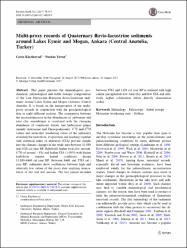Multi-proxy records of Quaternary fluvio-lacustrine sediments around Lakes Eymir and Mogan, Ankara (Central Anatolia, Turkey)
Abstract
This paper presents the mineralogical, geochemical, palynological and stable isotopic compositions of the Late Pleistocene-Holocene fluvio-lacustrine sediments around Lakes Eymir and Mogan (Ankara), Central Anatolia. It is based on the interpretation of the multiproxy records in conjunction with the geochronological data in eight different sections. The comparison between the increase/ decrease in the abundances of carbonates and total clay assemblages is correlated with the changing abundance of coniferous forests and herbaceous plants (mainly Asteraceae and Chenopodiaceae). delta C-13 and delta O-18 values and molecular weathering ratios of the sediments revealing the hydrolysis, evaporation and leaching together with chemical index of alteration (CIA) provide insight into the climatic changes in the study area between 11,899 and 1428 cal year BP. Relatively higher total clay amount, delta O-18 of around -8% and higher CIA (>40%) with higher hydrolysis suggest humid conditions during 11,899-6448 cal year BP. Between 6448 and 5763 cal year BP, sediments show oscillations between high and relatively low values of the proxy data implying intercalation of dry and wet seasons. The last period recorded between 5763 and 1428 cal year BP is realized with high calcite precipitation-low total clay and low CIA and relatively higher salinization which directly characterize aridity.


















